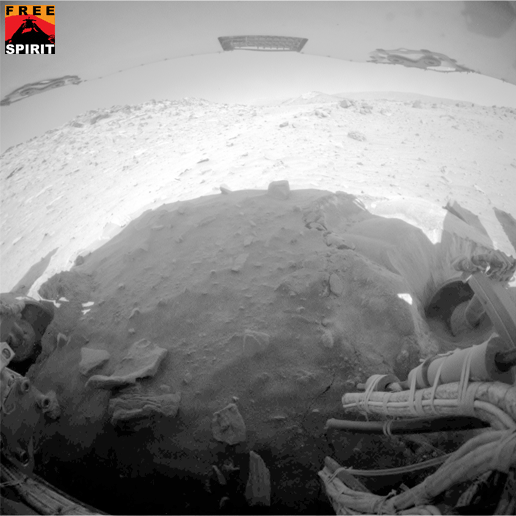NASA Abandons Escape Attempts for Stuck Mars Rover

Thisstory was updated at 3:47 p.m. ET.
The rovingdays are over for NASA's Mars rover Spirit after more than six years rollingacross the Martian surface, the space agency announced Tuesday.
NASAengineers have decided to abandon efforts to rescue the Spiritrover from the deep Martian sand that snared it in May 2009. Instead, they are trying to prepare the rover to survive the harsh winter ahead inMars? southern hemisphere. If the rover survives, it will serve as a fixedscience outpost, mission managers said.
?This isnot a day to mourn Spirit. This is not a day of loss,? said Doug McCuistion,director of NASA?s Mars exploration program, in a teleconference. ?Its drivingdays are likely over, however its contribution will continue.?
Spirit isstuck up to its wheel tops in Martiansand and slightly tilted back in a spot on Mars that scientists have named ?Troy.?The rover got stuck on May 6, when its wheels broke through a hard crustcovering the soft sand and sunk into the sand trap.
?Spirit hasencountered a golfer?s worse nightmare,? McCuistion said.
Engineersat NASA?s Jet Propulsion Laboratory (JPL) in Pasadena, Calif., spent months working onways to extract Spirit from its sandy predicament. Those efforts - which beganin November - have been unsuccessful. Making matters worse, two of the rover?ssix wheels are broken, hampering its escape attempts.
Get the Space.com Newsletter
Breaking space news, the latest updates on rocket launches, skywatching events and more!
Spirit andits robotic twin Opportunity have been exploring different parts of Mars sincethey landed in January 2004. Since then, the long-lived rovers have faroutlasted their initial 90-day mission plans and discovered new insights intothe history of wateron Mars. Opportunity is currently working fine and is studying an odd rockcalled ?Marquette Island? ? which appears to have been ejected from deep insideMars during an impact ? as it heads toward a giant crater called Endeavour.
McCuistioncalled Spirit?s situation ?inextractable.? He didn?t rule out that Spiritcould free itself by accident, but that?s not the goal anymore.
?Right now,our plan is to worry about getting through the winter,? McCuistion said.
Recentattempts to drive Spirit backwards have made some improvement to its tilttoward the sun, which is vital for the rover?s solar arrays to generate thepower to stay alive.
Duringwinters on Mars, the sun is low in the sky, so engineers try to perch Spiritand Opportunity on north-facing slopes to maximize the amount of sunlight theirtop-mounted solar panels can collect. NASA is hopeful thatSpirit can be wiggled into a favorable position before the full brunt of winterarrives in a few months.
Ifsuccessful, Spirit could continue to operate through the Martian winter, orpossibly enter a hibernation-like mode until the season passes and springtimereturns, bringing with it more favorable levels of sunlight.
?We havehope that Spirit will survive this cold, dark winter that we have ahead of usand be ready to do more science come springtime,? said the rover mission?sprincipal investigator Steven Squyres of Cornell University in Ithaca, New York.
Squyressaid Spirit can still study the Mars dirt around Troy. There is also a tantalizingchance for scientists to determine if the core of Mars is liquid or solid iron.They could do that by using Spirit?s radio signals to record the motion of Marsand deduce if the red planet?s core is molten or not, he added.
?Totallynew science,? Squyres said.
But first,Spirit must survive the next winter on Mars.
Roverproject manager John Callas of JPL said that, in the end, it will all come downto power. If Spirit does not find a good sunward tilt for the coming winter, itcould experience a so-called ?low-power fault? and shut down all non-essentialsystems.
?The rover willbe like a polar bear, hibernating,? Callas said. ?It could be for many months?onthe order of six months, that the rover will be in this state.?
Unlike NASA?slong-silent Phoenix Mars Lander in the Martian arctic, Spirit is designed tohibernate through winters on Mars and will experience frigid temperatures of minus 49 degrees Fahrenheit (minus 45degrees Celsius), Callas said. But Spirit is not a new rover, so its systemscould be susceptible to damage due to age, he added.
?There?s noguarantee that the rover will be able to survive these colder temperatures,?Callas said.
It willlikely be frustrating for NASA engineers as they await word from Spirit todetermine if the rover survives the coming winter. After all, NASA has spent$900 million on the Mars rover mission, and typically spends $20 million a yearto support Spirit and Opportunity during their extended treks on the redplanet.
?That?ll bechallenging for the team, but it?s just something we?ll have to be disciplinedabout,? Callas said.
- Video - Spirit: The Little Mars Rover That Could
- See Mars at Its Best Right Now
- Video Show - Rover Tracks on Mars
Join our Space Forums to keep talking space on the latest missions, night sky and more! And if you have a news tip, correction or comment, let us know at: community@space.com.

Tariq is the Editor-in-Chief of Space.com and joined the team in 2001, first as an intern and staff writer, and later as an editor. He covers human spaceflight, exploration and space science, as well as skywatching and entertainment. He became Space.com's Managing Editor in 2009 and Editor-in-Chief in 2019. Before joining Space.com, Tariq was a staff reporter for The Los Angeles Times covering education and city beats in La Habra, Fullerton and Huntington Beach. In October 2022, Tariq received the Harry Kolcum Award for excellence in space reporting from the National Space Club Florida Committee. He is also an Eagle Scout (yes, he has the Space Exploration merit badge) and went to Space Camp four times as a kid and a fifth time as an adult. He has journalism degrees from the University of Southern California and New York University. You can find Tariq at Space.com and as the co-host to the This Week In Space podcast with space historian Rod Pyle on the TWiT network. To see his latest project, you can follow Tariq on Twitter @tariqjmalik.
